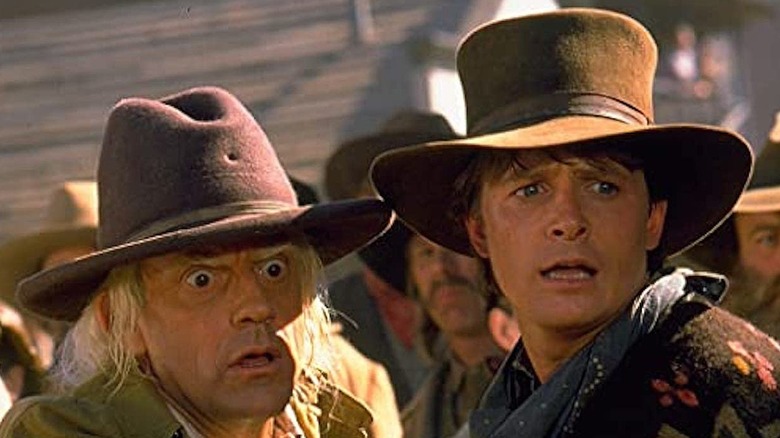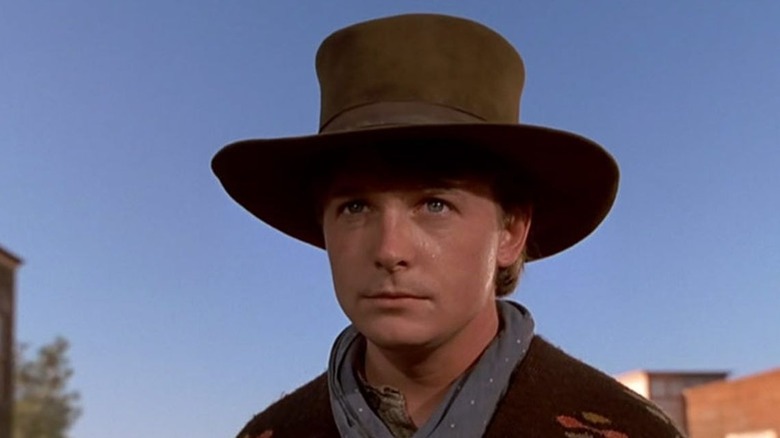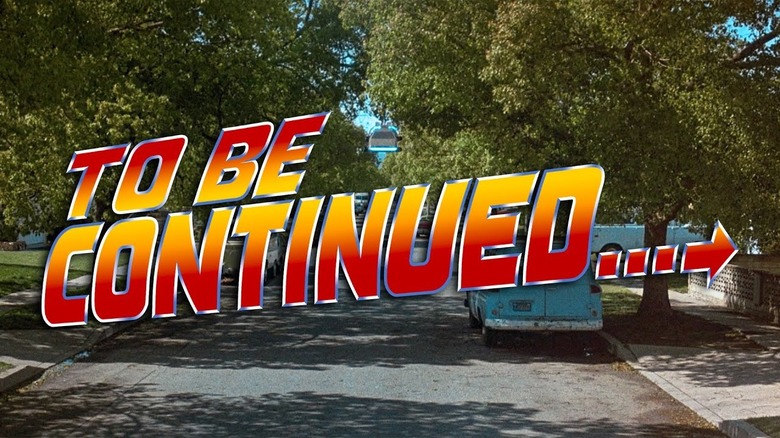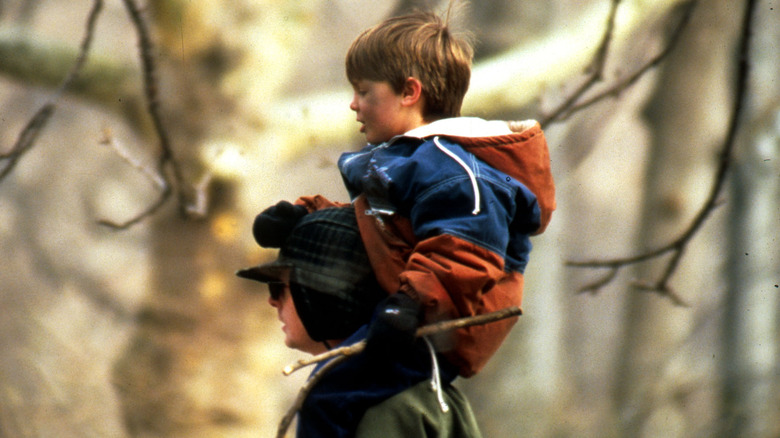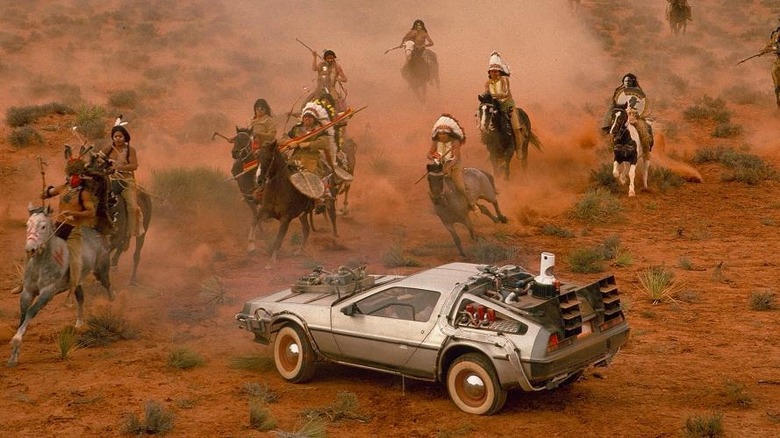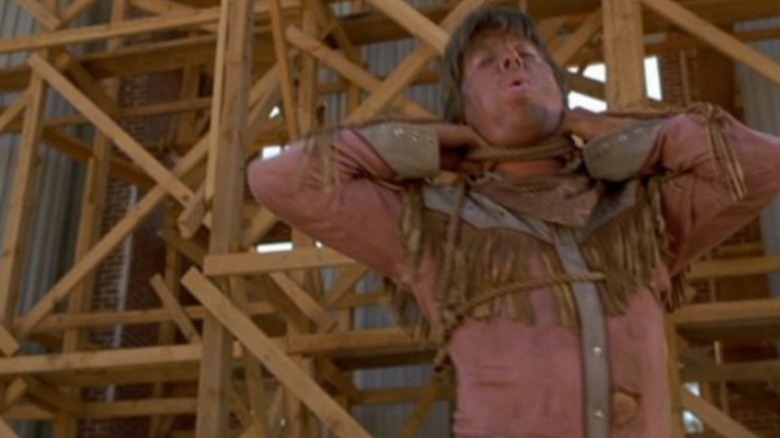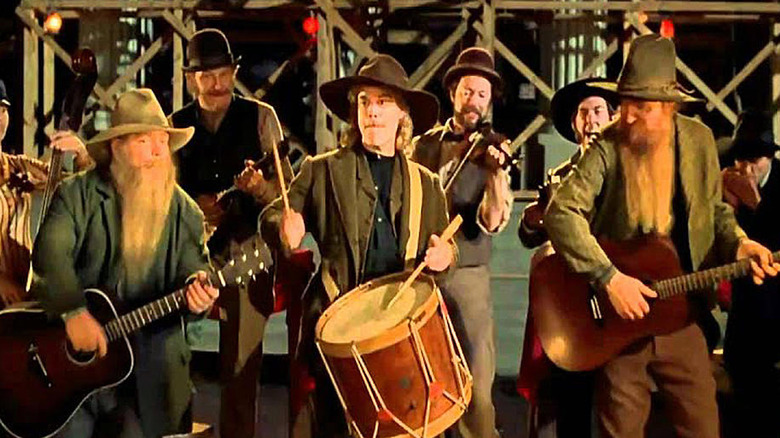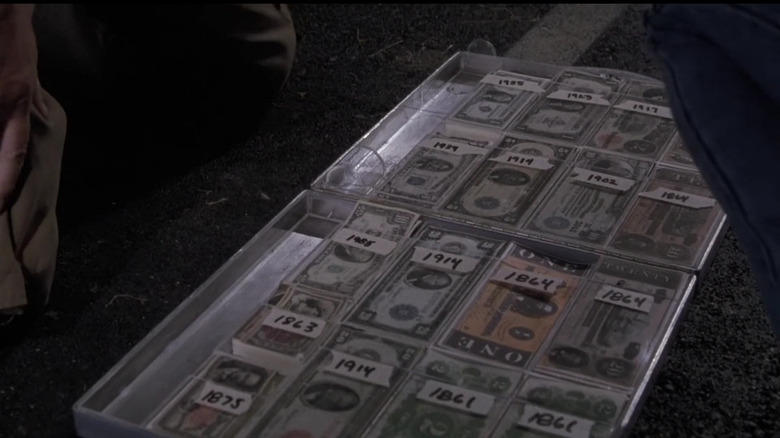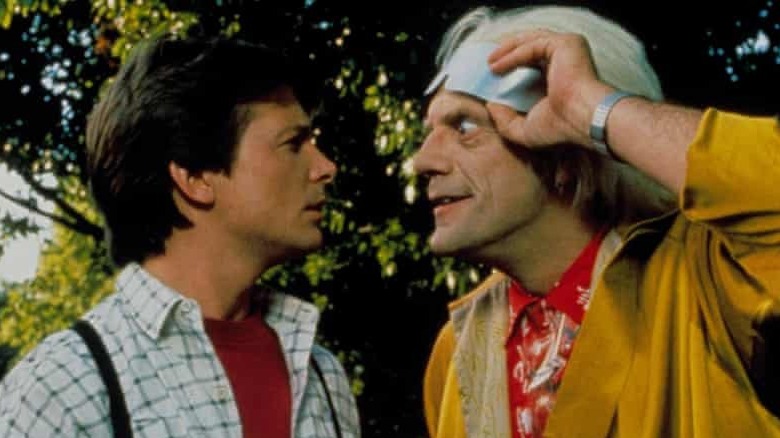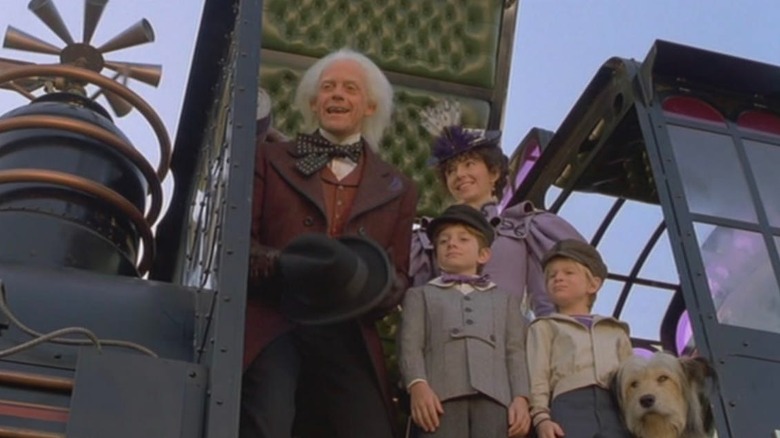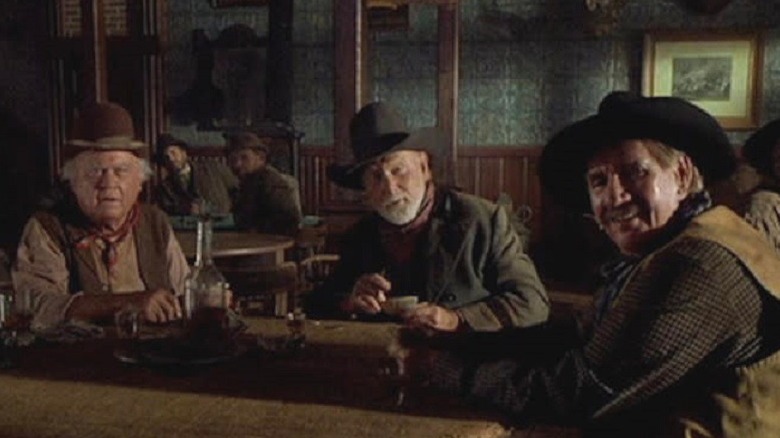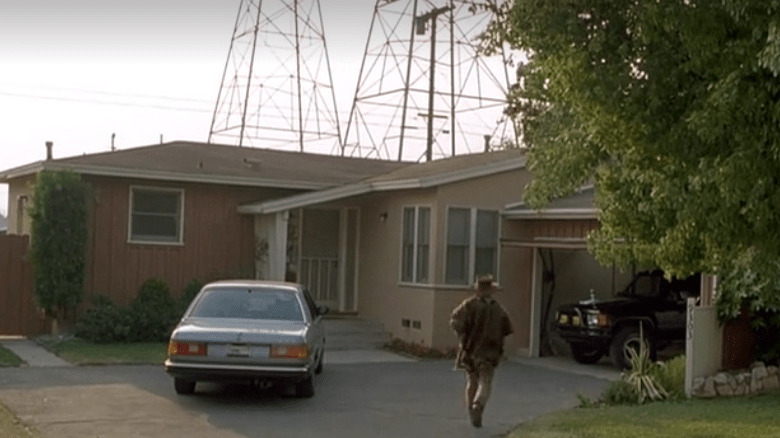What It Was Like Wrapping Up The Back To The Future Trilogy
"Back to the Future" is arguably the gold standard when it comes to time-travel films. When the team in "Avengers: Endgame" discuss their plan to go back in time and get the Infinity Stones, they jokingly refer to "Back to the Future" as their reference material. In "A Million Ways to Die in the West," there's a scene where the main character sees Doc Brown covering up his DeLorean in the old west, a direct reference to "Back to the Future III." Plenty of conventions are based on the movies. In "Hot Tub Time Machine," for example, when Jacob runs up against possibly not being born, he begins to flicker out like in "Back to the Future."
Michael J. Fox emerged from "Back to the Future" as a massive movie star. Director Robert Zemeckis' biggest movie was "Romancing the Stone" before "Back to the Future." After the movie hit, his career took off. Obviously the movie series changed the lives of everybody involved in it (some not necessarily for the better). After the blockbuster numbers delivered by the first film, Zemeckis and writing partner Bob Gale realized there would have to be a sequel. And that sequel turned into two films, shot in a grueling back-to-back format that ended when "Back to the Future III" exploded into theaters, completing one of the most iconic time travel stories with one of the oldest Hollywood genres, a Western.
Michael J. Fox decided on the old west
As the story goes, while shooting the first movie Robert Zemeckis asked Michael J. Fox where in time he'd want to go. Fox said the wild west and the rest was history, so to speak. Zemeckis and writer Bob Gale started working on their sequel script after the success of "Back to the Future," taking the time voyagers to the founding of Hill Valley.
Looking back, the Hill Valley origin story (and Doc's old-fashioned romance) fit so seamlessly with the trilogy that it works, especially in juxtaposition with the trip to the future and all the cool toys in "Part II." At the time, "Back to the Future" had built its success on its element of sci-fi time travel and the paradoxes presented by such a power. Which made changing "Back to the Future III" into basically just a western seem like a risk. As Roger Ebert pointed out in his review, "That looking-glass quality is missing, alas, from 'Back to the Future Part III,' which makes a few bows in the direction of time-travel complexities, and then settles down to be a routine Western comedy." No doubt there must have been some concerns among the many studio executives involved that this could be a problem, changing the formula that had worked so well in place of a Western.
Maybe that was why they had Doc miraculously escape a massive chasm on a hoverboard?
The sequels were written and shot as 1 big work
After the success of "Back to the Future," Robert Zemeckis and writer Bob Gale went to work creating the next chapter in the Hill Valley time travel adventure. What they first came up with was a single script called "Paradox," based on the central issue with time travel: paradoxes can come up due to inconsistencies that exist between the past, present, and future. Even more, "Back to the Future" was centered on how the slightest change in the past can drastically alter the future.
The script was eventually split into two films, though they were shot back-to-back to not only mitigate the aging of the actors between films. According to an LA Times interview with Zemeckis and Gale, that meant the director had to do post on "Part II" while filming "Part III." The piece mentions how the schedule meant "Zemeckis shot one movie from 6 a.m. until sundown, then caught a plane to Burbank, where he did post-production work on the other until late into the night. He then checked into the Sheraton Universal, got up at 5 a.m and took the 50-minute flight back north."
If only he'd had a time machine, or at least a flying car.
Michael J. Fox experienced new life and death over the shoot
Michael J. Fox was seemingly just as busy as Zemeckis, though he wasn't juggling shooting and post for two films. Instead he juggled other projects and plenty of family stuff. According to the LA Times article, Fox was wrapping up the final season of "Family Ties" in his role as rebelliously conservative Alex P. Keaton during the fix six weeks of "Back to the Future II." In May during that same year, however, Fox landed another responsibility: the birth of his son, Sam, which "compounded the intensity."
So he starts off the shoot splitting starring roles in a series and a film. Adds a son, Sam. And then he has a death. "In the course of that year [the year shooting 'Back to the Future Part II' and 'Part III'] my son was born and my father passed away," explains Fox in an extra behind the scenes documentary about filming "Back to the Future III." Fox continues, "So whole big cataclysmic things happen in your life and it's all tied to that movie."
The crew were excited to shoot a western
In a behind the scenes video, Bob Gale explains "shooting a western was a dream come true for a lot of people, particularly the stunt guys because not that many westerns are made anymore." Westerns used to dominate American cinema, and those films were filled with many of the classic American cinematic stunts: Horse riding, fights on top of trains, and shootouts where people go headfirst off balconies. In the '80s, however, not a lot of westerns were being shot. "So we had every great stuntman in Hollywood wanting to work on 'Back to the Future III.'" Plus, according to Gale, the actors were excited about learning to ride a horse and "the wranglers got excited about teaching these guys to ride a horse."
Another member of the team who was excited to do a western was cinematographer Dean Cundey. In an interview with the UCLA Daily Bruin, UCLA-alum Cundey discusses his cinematic experiences and especially his time on the "Back to the Future" series. He says, "Visually, I have to say 'Back to the Future III,' the Western portion, was my favorite. We dealt with shooting a period nostalgically. There are iconic Western visuals we used that create the illusion of that time period." Seeing as Cundey's cinematography CV also includes "Jurassic Park" and "Apollo 13," he probably knows a thing or two.
A film everybody's clamoring to work on? What could go wrong?
Michael J. Fox almost died
In "Back to the Future III," there's a scene where Buford "Mad Dog" Tannen drags Marty behind a horse and attempts to hang him from a noose. While the hanging is a stunt, they obviously needed Michael J. Fox since it was so close on his face. In rehearsals, Fox had done a decent job of maintaining enough space between the rope and his throat to safely pretend to hand. But when it came time to film, something went wrong and Fox was actually hung for real.
Apparently the actor was never really the same after the shoot. As Fox explains in his memoir "Lucky Man," he "swung unconscious at the end of the rope for several seconds before Bob Zemeckis, fan of me though he was, realized even I wasn't that good of an actor."
He was revived and lived to tell the tale. Time travel really is dangerous.
ZZ Top played in the old western band
It is a fact well-known by ZZ Top fans that they play the old west band during the 1885 Hill Valley Festival in "Back to the Future III." Apparently the bearded, sharp-dressed men looked very authentic. Frontman Billy Gibbons revealed to Express.co.uk, "Initially, we were, in fact, mistaken for old west extras by some of the crew after we arrived on set."
They had been asked to write a song for the movie, called "Doubleback" and even gave an impromptu concert during a camera issue. According to The Hollywood Reporter, not only did ZZ Top write a song and make a cameo in the film, they put on a show for cast and crew. At one point during filming, a camera broke down and had to be fixed. While Zemeckis saw to that, the boys with the beards began jamming, entertaining the cast and crew.
Back to the Future III had big box office shoes to fill
"Back to the Future" grossed $382 million on a $19 million budget. With that kind of success, and with the fact that the film ends nodding to a future adventure, it was obvious that there would have to be a sequel. Since "Part II" and "Part III" were shot back to back, they were both competing with the original but "Part III" would also be competing with "Part II."
As Michael J. Fox said in an LA Times story from 1989, "The horrible thing is that we'll still be shooting ['Part III'] when ['Part II'] opens. If it bombs, I'll be there in Monument Valley, Utah, putting my hand to my head ... 'Oh, my God!' "
Though what happened was a bit different. While "Back to the Future Part II" cost $40 million to make, it still grossed over $330 million worldwide. Even more, its $118 million domestic gross made it the 7th-highest in 1989. Obviously the pressure was on for "Part III."
Alas, it had a slightly-more-anemic global of $245 million and domestically it didn't even break $90 million. While at the time it received its fair share of negative reviews, "Part III" has recently received a resurgence.
Michael J Fox and Christopher Lloyd were obviously good friends
The "Back to the Future" series obviously had a huge impact on the careers of actors Michael J. Fox and Christopher Lloyd. The films were Fox's first real blockbusters. Lloyd got his first onscreen kiss, with Mary Steenburgen no less. Plus obviously in the movie they created characters who even at the time people were already seeing as iconic. As Lloyd himself told Looper, "It's a thrill whenever we get together. [Fox] has just such a loving, wonderful sense of himself in his situation in time."
This friendship was no doubt part of the reason for his joining the Discovery+ docuseries "Expedition: Back to the Future" in support of the Michael J. Fox Foundation for Parkinson's Research. Their recent reunion speaks to the fact that they still care deeply for each other.
One could only imagine, then, how bittersweet their final days working together were. Obviously their time together onset was enjoyable enough to spark a friendship that outlasted the passage of time.
Gale added the final line as a joke
Robert Zemeckis and Universal said during the shooting of "Back to the Future Part III" that "there will be no 'Back to the Future Part IV.' " That is still unchanged, with Zemeckis, one of the two rights-holders on the project (the other being Bob Gale) answering a question from the Telegraph about a possible fourth installment with "Oh, God no." He continues with, "That can't happen until both Bob and I are dead. ... It's like saying 'Let's remake 'Citizen Kane.' Who are we going to get to play Kane?"
Yet the series ends with Doc, Clara, and their children arriving in 1985 in a time-traveling train to say goodbye to Marty. Marty asks if Doc is going to take the family to the future and Doc says, "Nope, already been there." Gale told The Hollywood Reporter, "It's a joke! It's just showmanship." So there will likely never be another feature film installment in our time. That said, the Hollywood Reporter article was centered on the comic books, co-written by Gale, that have at least added some new stories for the "BTTF" fans clamoring to continue the journey through time.
Old western actors and shots were included in the movie
Monument Valley has appeared in so many legendary movies, from "The Searchers" to "Easy Rider," that most people would recognize it. Its appearance in "Back to the Future III," then, is a direct reference to the movie's place in the western genre. The film is chock full of amazing locations. Some scenes were filmed on location in Oak Park and the 1885 Hill Valley being filmed in Jamestown. Some of the railway scenes were shot at Railtown 1897 State Historic Park in Jamestown, a location that also appeared in "High Noon."
Another nod to old westerns is the inclusion of Pat Buttram, Harry Carey Jr., and Dub Taylor as the three old timers in the saloon. Pat Buttram starred in dozens of western films and TV series. Harry Carey Jr. had the same, with a filmography spanning from "Red River" to the TV series "Gunsmoke" to "Tombstone." Dub Taylor also has a long list of roles, specifically his long run as Cannonball, sidekick to Wild Bill Elliott in 13 movies; he also appeared in "The Wild Bunch" and many others.
Between the locations and the inclusion of these legit western actors, "Back to the Future III" was truly a homage to classic westerns.
A neighbor got behind-the-scenes camcorder footage
"Back to the Future Part III" was shot at plenty of places in the southwest, from open lands to standard movie sets on the Universal lot. But one spot that wasn't manufactured, that wasn't a vast open land with long sight lines or a closed studio lot, was the McFly residence.
At the end of the movie, Marty returns to his house in 1985 Hill Valley still wearing his poncho. Marty just lost the Delorean to a train and runs home to find Jennifer and his family at home now returned to the reality that ended "Back to the Future," after the disturbing events of "Back to the Future II."
While they were shooting this, one of the final scenes, an unidentified neighbor got some amateur camcorder footage of cast and crew hanging out, filming, goofing off. It's a pretty neat bit of cinema verité showing not only how many people worked on this but also how much Michael J. Fox himself really seemed to enjoy it. Fox at one point even grabs a still camera and takes pictures of the cast and crew.
One thing is glaringly obvious from the footage: Fox really seemed to love shooting "Back to the Future III."
